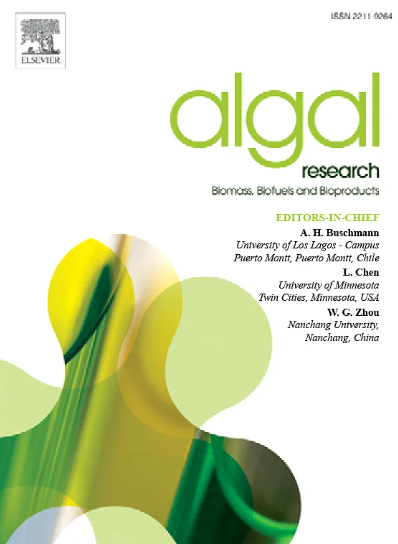Green synthesis of titanium oxide nanoparticles using aqueous extracts of Limnospira fusiformis and their multifunctional applications in biomedical and biodiesel production
IF 4.5
2区 生物学
Q1 BIOTECHNOLOGY & APPLIED MICROBIOLOGY
Algal Research-Biomass Biofuels and Bioproducts
Pub Date : 2025-05-08
DOI:10.1016/j.algal.2025.104082
引用次数: 0
Abstract
Biosynthesis of Titanium oxide nanoparticles (TiO2 NPs) is an emerging strategy that is being commonly employed in industrial and environmental wastewater treatments. This study adopted green chemistry technique to synthesize TiO2 NPs, utilizing aqueous extract derived from cyanobacteria Limnospira fusiformis. A comprehensive characterization of the biogenic TiO2 NPs was performed using spectroscopic and microscopic analysis. Antibiofilm potential of TiO2 NPs was tested against human pathogens, specifically in Pseudomonas aeruginosa (Gram-negative) and Bacillus subtilis (Gram-positive) bacteria. Cytotoxicity of TiO2 NPs was assessed against the cancer cell lines, human lung A549 and breast MDA-MB-231 employing MTT assay. The study also investigated the conversion of oil extracted from microalgae consortium (Chlorella vulgaris + Scenedesmus dimorphus), into biodiesel at varying catalyst concentration. In this study, the UV–visible spectrum of biogenic TiO2 NPs exhibited a sharp absorption peak at 254 nm. FTIR analysis revealed peaks at 424, 1398, 1632, and 3479 cm−1. XRD pattern shows five intense broad peaks indexed as (101), (004), (200), (105), and (205). SEM images displayed spherical-shaped structures in clustered form of TiO2 NPs. The presence of titanium and oxygen was further confirmed by the EDS profile. Zeta potential and dynamic scattering analysis illustrated the TiO2 NPs were highly stable at −49.4 mV with a mean size of 98.9 nm. Differential Thermal Analysis (DTA) and Thermogravimetric Analysis (TGA) confirmed the successful functionalization of TiO2 NPs. Biogenic TiO2 NPs exhibited a promising effect against Bacillus subtilis and the MDA-MB-231 cancer cell lines at 20 μg/mL and 10 μg/mL concentration, correspondingly. This research also revealed that these green-synthesized TiO2 NPs performed as an effective catalyst for converting algal lipids into biodiesel. Maximum amount of FAME was produced at 6 mg/mL concentration. Moreover, these green-synthesized NPs show promising nano-biomaterials for various applications in biomedicine and could also significantly improve the large-scale production of biodiesel.

利用梭形Limnospira fusiformis水提物绿色合成氧化钛纳米颗粒及其在生物医学和生物柴油生产中的多功能应用
二氧化钛纳米颗粒(TiO2 NPs)的生物合成是一种新兴的技术,在工业和环境废水处理中得到广泛应用。本研究采用绿色化学技术,利用梭状蓝藻Limnospira fusiformis的水提物合成TiO2 NPs。利用光谱学和显微分析对TiO2纳米粒子进行了全面表征。研究了TiO2 NPs对人体病原菌(革兰氏阴性)和枯草芽孢杆菌(革兰氏阳性)的抗菌膜电位。采用MTT法测定TiO2 NPs对肿瘤细胞系、人肺A549和乳腺MDA-MB-231的细胞毒性。本研究还研究了不同催化剂浓度下微藻联合体(小球藻+双叶藻)提取的油脂转化为生物柴油的过程。在本研究中,生物源TiO2 NPs的紫外可见光谱在254 nm处有一个尖锐的吸收峰。FTIR分析显示峰位于424、1398、1632和3479 cm−1。XRD谱图显示5个强宽峰,分别为(101)、(004)、(200)、(105)和(205)。SEM图像显示TiO2 NPs呈球状簇状结构。EDS谱进一步证实了钛和氧的存在。Zeta电位和动态散射分析表明,TiO2纳米粒子在- 49.4 mV下高度稳定,平均尺寸为98.9 nm。差热分析(DTA)和热重分析(TGA)证实了TiO2 NPs的成功功能化。生物源TiO2 NPs分别在20 μg/mL和10 μg/mL浓度下对枯草芽孢杆菌和MDA-MB-231癌细胞表现出良好的抑制作用。该研究还发现,这些绿色合成的TiO2 NPs可以作为将藻类脂质转化为生物柴油的有效催化剂。在浓度为6 mg/mL时产生的FAME量最大。此外,这些绿色合成的NPs显示出在生物医学领域的各种应用前景的纳米生物材料,也可以显著提高生物柴油的大规模生产。
本文章由计算机程序翻译,如有差异,请以英文原文为准。
求助全文
约1分钟内获得全文
求助全文
来源期刊

Algal Research-Biomass Biofuels and Bioproducts
BIOTECHNOLOGY & APPLIED MICROBIOLOGY-
CiteScore
9.40
自引率
7.80%
发文量
332
期刊介绍:
Algal Research is an international phycology journal covering all areas of emerging technologies in algae biology, biomass production, cultivation, harvesting, extraction, bioproducts, biorefinery, engineering, and econometrics. Algae is defined to include cyanobacteria, microalgae, and protists and symbionts of interest in biotechnology. The journal publishes original research and reviews for the following scope: algal biology, including but not exclusive to: phylogeny, biodiversity, molecular traits, metabolic regulation, and genetic engineering, algal cultivation, e.g. phototrophic systems, heterotrophic systems, and mixotrophic systems, algal harvesting and extraction systems, biotechnology to convert algal biomass and components into biofuels and bioproducts, e.g., nutraceuticals, pharmaceuticals, animal feed, plastics, etc. algal products and their economic assessment
 求助内容:
求助内容: 应助结果提醒方式:
应助结果提醒方式:


